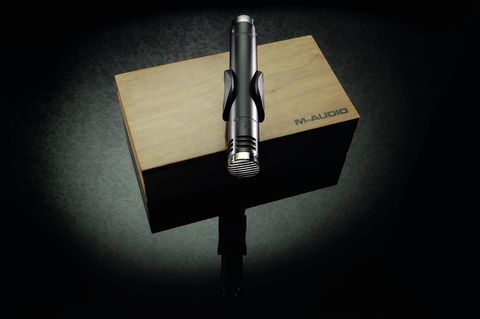Think of a microphone manufacturer and chances are M-Audio wouldn't be the first company to pop into your head. This is a company most of us associate principally with audio interfaces and MIDI controller keyboards.
It's easy to forget that a range of affordable, good-quality mics lie within M-Audio's product line but that could be about to change. M-Audio's Pulsar microphone has been available for some time now, but it's just been given a pretty significant overhaul and the new features deserve to put it on the map.
The original Pulsar offered a cardioid-pattern with a three-quarter-inch diameter diaphragm. Its body was made of brass and it offered good quality recording with relatively low noise. The Pulsar II builds on this and looks to offer subtle improvements across the board.
For starters, you'll now find 10dB pad and high-pass filter switches, the latter of which begins roll-off at 80Hz. These two switches lie along the microphone's side and their inclusion means that the Pulsar is now suitable for a wider range of close-miking applications.
Keep something close and pointy with you if you intend to change settings regularly, as the switches are small and recessed.
The most significant structural difference is that the back plate has been completely redesigned and is now hand-made of solid brass. The quoted signal quality is improved and this, coupled with reduced internal noise, means that it should present as a microphone reborn.
In use
Once attached to your microphone stand with the included clip, the Pulsar II offers an open, relatively neutral sound. On voice, recorded signals are punchy yet warm, with little sense of unnaturally enhanced sibilance.
The sound is clear and focused and I was pleased to find that the mic picks up decent amounts of signal from the side, meaning that the problems of too direct a signal, common to this microphone type, are avoided.
However, most potential users will show interest in the Pulsar II as a close-contact microphone for instruments and it's here that the sound really begins to shine. I tested it recording violin and the sound was clean, clear and warm, with very little colouration.
Its performance suggests it would also make it an excellent choice both as an acoustic guitar mic and, when used in combination with a matched pair, as a drum kit overhead.
The mic's re-design is a job well done. Its construction is improved, it packs a few more features in and, most importantly, it sounds better than its predecessor. Everything about this package has been shifted up a notch; the mic even ships in a rugged wooden box now, as opposed to the original Pulsar's soft case.
It's more than reasonably priced and can do a good job in a number of recording situations. If you're looking for a clean-sounding, unfussy mic you can turn to when recording vocals and a range of instruments, you'd do well to try out the Pulsar II.


